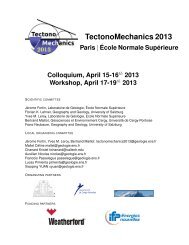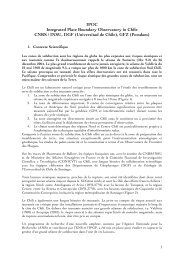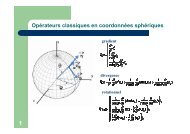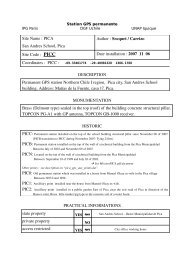PDF file - Laboratoire de Géologie de l'Ecole normale supérieure - Ens
PDF file - Laboratoire de Géologie de l'Ecole normale supérieure - Ens
PDF file - Laboratoire de Géologie de l'Ecole normale supérieure - Ens
You also want an ePaper? Increase the reach of your titles
YUMPU automatically turns print PDFs into web optimized ePapers that Google loves.
X - 10 SIMONS ET AL.: GPS MEASUREMENTS IN S.E. ASIA TO REFINE SUNDALAND MOTION<br />
that any revision of the Sundaland pole needs to be based on both<br />
more AND more accurate velocity estimates on the rigid part of<br />
Sundaland. If in this paper the same selection of 10 sites would be<br />
used as in Michel et al. [2001], which also inclu<strong>de</strong>d GEODYSSEA<br />
sites in Central Java and in Bali, the pole rate would slow down<br />
slightly and its location would shift towards the one of Michel et al.<br />
[2001].<br />
Therefore only with the significantly expan<strong>de</strong>d, more accurate<br />
and well spread velocity field presented in this paper it ma<strong>de</strong> scientific<br />
sense to update the Sundaland motion, thereby clearly i<strong>de</strong>ntifying<br />
and/or removing sites that are in <strong>de</strong>forming regions.<br />
4.3. Stable Sundaland rigidity and boundaries <strong>de</strong>formation<br />
Fig. 7 focuses on both the intra- and inter-plate <strong>de</strong>formation in<br />
South-East Asia. The strain rate tensors have been computed from<br />
the velocity solution presented in this paper, except for TAIW station<br />
whose velocity was taken from ITRF-2000 because there are<br />
only 2 epochs with poor data quality and relatively short time span<br />
inclu<strong>de</strong>d in our data analysis.<br />
4.3.1. Stable Sundaland <strong>de</strong>finition<br />
From the analysis of the strain rates tensors, it is possible to localize<br />
a zone of very low strain rate (red crosses) which constitutes<br />
the rigid core of Sundaland. This stable core of the Sundaland block<br />
can also be <strong>de</strong>fined from the stations with a residual velocity with<br />
respect to Sundaland smaller than 3 mm/yr (red dots), almost all of<br />
which have been used to compute the pole. Hence, there is a very<br />
good agreement between the analysis of the residual velocities and<br />
the one of the strain rate tensors.<br />
The core of the Sundaland block (green area) covers the Indochina<br />
peninsula to the North, the Malaysian peninsula to the West, the<br />
Sunda shelf, the major part of Borneo to the East and extends to the<br />
South almost until the Java island.<br />
Another zone of small strain rates is the stable South China block,<br />
outlined by a pink area.<br />
Around the Sundaland block, inter-plate <strong>de</strong>formation rates can reach<br />
very high values (Fig. 7, black crosses) due to the motion of Sundaland<br />
block relative to its neighboring plates. It is possible to see a<br />
progressive increase in the <strong>de</strong>formation rate from the core of Sundaland<br />
(red crosses) to its boundaries (green and blue crosses). These<br />
zones of medium <strong>de</strong>formation rate surrounding the rigid core seem<br />
to indicate that high-rate inter-plate <strong>de</strong>formation is not completely<br />
localized at the boundaries but extends a bit insi<strong>de</strong> the Sundaland<br />
block. However, it is not possible to <strong>de</strong>termine whether the origin<br />
of these medium strain rates is due to elastic coupling on a single<br />
fault accommodating the major part of inter-plate motion or to a<br />
distribution of the <strong>de</strong>formation on several smaller scale faults in<br />
the boundary areas. Discriminating these two <strong>de</strong>formation mo<strong>de</strong>s<br />
needs locally <strong>de</strong>nsified GPS measurements in or<strong>de</strong>r to constrain the<br />
mechanical mo<strong>de</strong>ls.<br />
4.3.2. Deformation at the Sundaland boundaries<br />
The highest strain rates are located along the eastern bor<strong>de</strong>r of<br />
the Sundaland block, in the Philippine belt and Sulawesi island<br />
(Fig. 7). In the latest area, the main compressive strain axis rotates<br />
anti-clockwise from NNE-trending at the NE of the island to<br />
NNW-trending North of the island (Minahassa trench) and until<br />
WNW-trending East of the island (Palu left-lateral strike-slip fault).<br />
To the West, <strong>de</strong>formation seems to extend, at smaller rates, in the<br />
eastern part of Borneo island. To the south of Sulawesi island the<br />
main compressive strain axis trends generally NNW.<br />
To the South, the Sundaland block is boun<strong>de</strong>d by the arcuate Sunda<br />
trench. There, the main compressive strain axis remains normal to<br />
the subduction axis (fig. 7), and hence rotates slightly clockwise<br />
from NNW-trending to the East (South of Sulawesi and Flores islands)<br />
to NE-trending to the West, in the Sumatra area.<br />
To the West, the Sundaland block is boun<strong>de</strong>d by a right-lateral strikeslip<br />
zone extending from Sumatra to Myanmar. The Sumatra shear<br />
zone is affected by <strong>de</strong>formation compatible with right-lateral strikeslip<br />
on the Great Sumatran Fault. Further to the North, our results<br />
confirm a right-lateral strike-slip on the Sagaing fault in Myanmar<br />
[Vigny et al., 2003]. Deformation of this area is <strong>de</strong>tailed in Socquet<br />
et al. [2003, subm.] in or<strong>de</strong>r to un<strong>de</strong>rstand how the relative motion<br />
between India and Sundaland is accommodated in Myanmar.<br />
The Northern boundary of Sundaland extends from the Eastern Himalayan<br />
Syntaxis until the South China sea, through the Red River<br />
Fault. There, the main compressive strain directions rotates from<br />
NE-trending to the West, to N-trending to the East. Strain tensors<br />
are compatible with right-lateral shear across the Red River Fault,<br />
the boundary between the Sundaland and the South China blocks.<br />
To the SE, this fault ends in the South China Sea Basin, characterized<br />
by very slow present-day strain rate and that may be consi<strong>de</strong>red<br />
as a diffuse boundary zone (fig. 7).<br />
4.4. Motion relative to Eurasia and other plates<br />
The motion of Sundaland with respect to Eurasia is the subject<br />
of discussions since the first GPS measurements in S.E. Asia [e.g.<br />
Tregoning et al., 1994; Genrich et al., 1996; Wilson et al., 1998;<br />
Chamot-Rooke et al., 1998; Simons et al., 1999; Michel et al., 2001]).<br />
Figure 8. Velocities in South-East Asia, with respect to Eurasia<br />
of Calais et al. [2003]. Black arrows are for sites belonging to<br />
Sunda, white ones for South China and gray ones for other areas.<br />
the major tectonic structures of the area are also shown as black<br />
lines.






